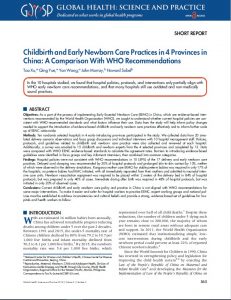
Objectives
As a part of the process of implementing Early Essential Newborn Care (EENC) in China, which are evidence-based interventions
recommended by the World Health Organization (WHO), we sought to understand whether current hospital policies are consistent
with WHO-recommended standards and what factors influence their use. Data from the study will help inform policy changes
needed to support the introduction of evidence-based childbirth and early newborn care practices effectively and to inform further scale
up of EENC nationwide.
Methods
Ten randomly selected hospitals in 4 early-introducing provinces participated in the study. We collected data from 20 simulated
delivery scenario observations and focus group discussions and individual interviews with 10 hospital management staff. Policies,
protocols, and guidelines related to childbirth and newborn care practice were also collected and reviewed at each hospital.
Additionally, a survey was emailed to 15 childbirth and newborn experts from the 4 selected provinces and completed by 13. Data
were compared with WHO EENC evidence-based standards to calculate the agreement rates. Barriers to introducing evidence-based
guidelines were identified in focus groups and key informant interviews, then combined into common categories.
Findings
Hospital policies were not consistent with WHO recommendations in 10 (59%) of the 17 delivery and early newborn care
practices. Delayed cord clamping was recommended by 30% of hospital protocols and prolonged skin-to-skin contact by 13%, neither
of which were observed in the delivery simulations. Kangaroo mother care (KMC) for stable preterm babies was required in only 17% of
the hospitals; no preterm babies had KMC initiated, with all immediately separated from their mothers and admitted to neonatal intensive
care units. Newborn resuscitation equipment was required to be placed within 2 meters of the delivery bed in 84% of hospital
protocols, but was prepared in only 40% of cases. Immediate drying after birth was required in 48% of hospital protocols, but was
initiated in only 20% of observed cases.
Conclusions
Current childbirth and early newborn care policy and practice in China is not aligned with WHO recommendations for
some major interventions. To make it easier and safer for hospital workers to practice EENC, expert working groups and national policies
must be established to address inconsistencies and cultural beliefs and provide a strong, evidence-based set of guidelines for hospitals
and health workers to follow.